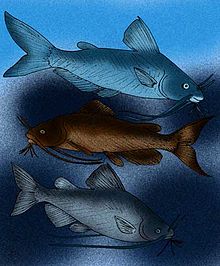Catfish

| Catfish Temporal range: Upper Cretaceous – Recent | |
|---|---|
 | |
| Eel-tail catfish | |
| Scientific classification | |
| Kingdom: | |
| Phylum: | |
| Class: | |
| Superorder: | |
| Order: | Siluriformes |
| Type species | |
| Silurus glanis Linnaeus, 1758 | |
Catfish are an order of teleost fish, the Siluriformes. There are about 40 families in the order.
They are called catfish because their barbels look like the whiskers of a cat. They are very diverse. The heaviest is the Mekong giant catfish, up to 350 kg (770 lb). The longest is the wels catfish, up to 4 m (13 ft). There are also detrivores in the group. There are some tiny parasitic catfish called candiru. Some catfish are grown for food, in fish farms. Some catfish can be kept in aquaria.
Special lifestyles
[change | change source]Most catfish do not harm people, but some of them can cause problems. It is said that the candiru can enter the human urethra, where they stay as parasites. In normal life they are parasites on fish gills.
The Malapteruridae are a family of electric catfish. Several species of the family can produce an electric shock of up to 350 volts using electroplaques of an electric organ.[1]
Types of catfish
[change | change source]Wels catfish
[change | change source]The wels catfish (Silurus glanis) is a large catfish.
Corydoras
[change | change source]Corydoras is a genus of popular aquarium fishes.
Widemouth blindcat
[change | change source]The widemouth blindcat (Satan eurystomus) is another species of catfish.
Madtoms
[change | change source]Madtoms are catfish comprising the genus Noturus.
Channel catfish
[change | change source]
The channel catfish (Ictalurus punctatus) is a North American freshwater catfish.
Ecology
[change | change source]As invasive species
[change | change source]
Species of the genus Ictalurus have been introduced into European waters in the hope of obtaining a sporting and food resource. Walking catfish have also been introduced in the freshwater areas of Florida.

